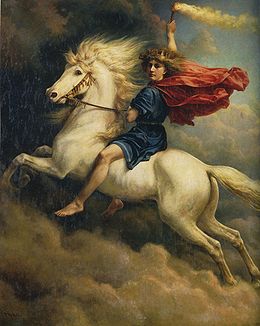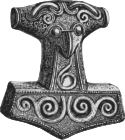- Dagr
-
 Dagr (1874) by Peter Nicolai Arbo
Dagr (1874) by Peter Nicolai Arbo For other uses of Dagr and Dagur, see Dagr (disambiguation).
For other uses of Dagr and Dagur, see Dagr (disambiguation).In Norse mythology, Dagr (Old Norse "day"[1]) is day personified. This personification appears in the Poetic Edda, compiled in the 13th century from earlier traditional sources, and the Prose Edda, written in the 13th century by Snorri Sturluson. In both sources, Dagr is stated to be the son of the god Dellingr and is associated with the bright-maned horse Skinfaxi, who "draw[s] day to mankind". The Prose Edda adds that Dagr is Dellingr's son by Nótt, the personified night. Otherwise, Dagr appears as a common noun simply meaning "day" throughout Old Norse works. Connections have been proposed between Dagr and other similarly named figures in Germanic mythology.
Contents
Attestations
Poetic Edda
Dagr is mentioned in stanzas 12 and 25 of the poem Vafþrúðnismál. In stanza 24, the god Odin (disguised as "Gagnráðr") asks the jötunn Vafþrúðnir from where the day comes, and the night and its tides. In stanza 25, Vafþrúðnir responds:
- Delling hight he who the day's father is,
- but night was of Nörvi born;
- the new and waning moons the beneficient powers created,
- to count the years for men.[2]
In Sigrdrífumál, after the valkyrie Sigrdrífa is woken from her sleep curse by the hero Sigurd, Sigurd asks her name, and she gives him a "memory-drink" of a drinking horn full of mead, and then Sigrdrifa says a prayer. The first verse of this prayer features a reference to the "sons of Dagr" and the "daughter of Nótt":
- Hail to the Day! Hail to the sons of Day!
- To Night and her daughter hail!
- With placid eyes behold us here,
- and here sitting give us victory.
In the poem Hrafnagaldr Óðins, the appearance of Dagr and his horse and chariot are described:
Prose Edda
In the Prose Edda book Gylfaginning, Dagr is again personified. In chapter 10, the enthroned figure of High states that Dagr is the son of the couple of Dellingr of the Æsir and his wife Nótt ("night"). Dagr is described as "as bright and beautiful as his father's people". Odin took Dagr and his mother Nótt, gave them each a chariot and a horse — Dagr receiving the horse Skinfaxi, whose mane illuminates all the sky and the earth — and placed them in the sky to ride around the earth every 24 hours.[6]
Dagr is again personified in chapter 24 of the Prose Edda book Skáldskaparmál, where he is stated as a brother of Jörð.[7] As a common noun, Dagr appears in chapter 58, where "Skinfaxi or Glad" is stated as pulling forth the day,[7] and chapter 64, where Dagr is stated as one of various words for time.[8]
Theories
Otto Höfler theorized that Dagr may be related to (or may be the same figure as) the hero Svipdagr (whose name means "the suddenly dawning day") who is attested in various texts. Among other sources, this figure is found in two poems compiled together and known as Svipdagsmál in the Poetic Edda, the Prologue to the Prose Edda, and by the name Swæfdæg in the mythical genealogies of the Anglian houses of Anglo-Saxon England. Otto Höfler also proposed that Svipdagr may have been a "Dagr of the Suebi", and because of the names of his family members, Sólbjartr ("the sun-light", indicating a potential god of the skies) and Gróa ("growth", indicating a possible goddess of growth), and his wooing of Menglöð (often identified with the goddess Freyja), he further suggested that Svipdagr may have been a fertility god.[9]
See also
- Dagaz, the d rune.
Notes
References
- Byock, Jesse (Trans.) (2006). The Prose Edda. Penguin Classics. ISBN 0140447555
- Faulkes, Anthony (Trans.) (1995). Edda. Everyman. ISBN 0-4608-7616-3
- Larrington, Carolyne (Trans.) (1999). The Poetic Edda. Oxford World's Classics. ISBN 0192839462
- Lindow, John (2001). Norse Mythology: A Guide to the Gods, Heroes, Rituals, and Beliefs. Oxford University Press. ISBN 0-19-515382-0
- Simek, Rudolf (2007) translated by Angela Hall. Dictionary of Northern Mythology. D.S. Brewer. ISBN 0859915131
- Thorpe, Benjamin (Trans.) (1866). Edda Sæmundar Hinns Frôða: The Edda of Sæmund the Learned. Part I. London: Trübner & Co.
- Thorpe, Benjamin (Trans.) (1907). The Elder Edda of Saemund Sigfusson. Norrœna Society.
Personifications and cosmology in Norse mythology Astronomical bodies Sun: (Sól · Árvakr and Alsviðr) · Moon: (Máni · Hjúki and Bil) · Earth: (Jörð · Fjörgyn and Fjörgynn) · Aurvandil
Time Worlds Nine Worlds: (Álfheimr · Asgard · Svartálfaheimr · Midgard · Múspellsheimr · Niðavellir · Niflheim · Jötunheimr · Vanaheimr) · Connected by the tree YggdrasilOther Norse paganism Deities,
heroes,
and figuresOthersAsk and Embla · Dís (Norns · Valkyries) · Dwarf · Einherjar · Elves (Light elves · Dark elves) · Fenrir · Hel · Jörmungandr · Jötunn · Sigurd · Völundr · Vættir
Locations Asgard · Bifröst · Fólkvangr · Ginnungagap · Hel · Jötunheimr · Midgard · Múspellsheimr · Niflheim · Valhalla · Vígríðr · Wells (Mímisbrunnr · Hvergelmir · Urðarbrunnr) · YggdrasilEvents Sources Society See also
Wikimedia Foundation. 2010.
